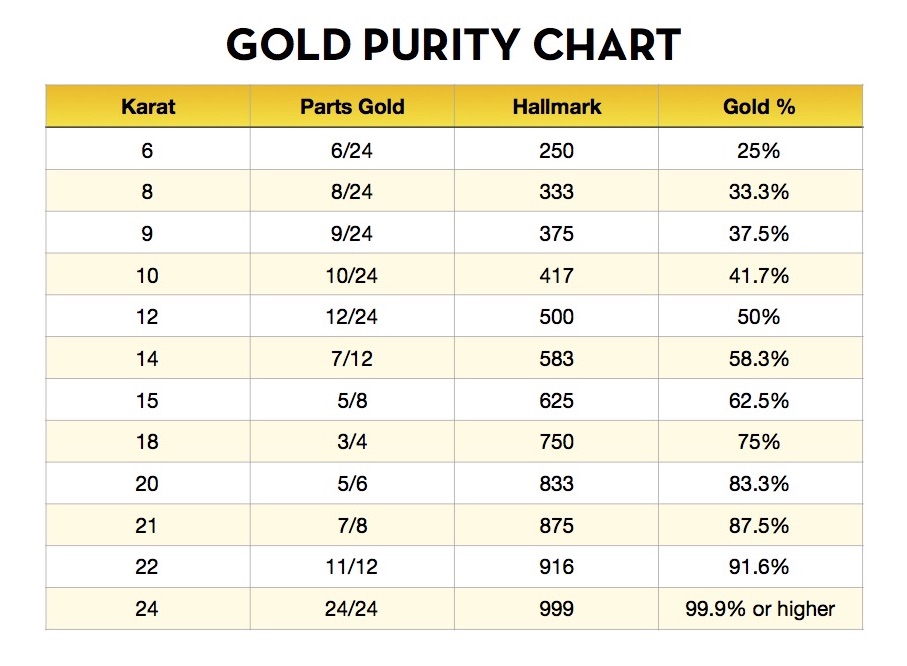Understanding Gold Karats: A Guide to Choosing the Right Gold for You
Gold jewelry and accessories often come in various karat options, each with its unique blend of purity, durability, and appearance. Understanding the differences between gold karats can help you make an informed choice when purchasing fine jewelry.
What is a Karat?
In gold, a karat (abbreviated as “k” or “kt”) measures its purity. Pure gold is 24 karats, meaning it is composed of 100% gold. Since pure gold is soft and malleable, it’s often mixed with other metals to increase durability, creating different karat levels.
Each karat represents 1/24th of the whole, meaning a 24-karat gold piece is 100% pure gold, while 18-karat gold is 18 parts gold and 6 parts other metals, or 75% pure gold.
The Most Common Gold Karats
1. 24-Karat Gold (24K)
- Purity: 99.9% pure gold.
- Color: Bright yellow, the most intense gold color.
- Durability: Very soft and prone to scratching or bending.
- Use: Common in investment-grade gold, collectibles, and high-end jewelry, especially in regions like Asia and the Middle East.
Pros: Pure and hypoallergenic, with a beautiful, intense yellow shine. Cons: Soft and not ideal for daily wear; expensive due to high purity.
2. 22-Karat Gold (22K)
- Purity: 91.7% pure gold, mixed with 8.3% other metals.
- Color: Deep yellow, slightly lighter than 24K.
- Durability: More durable than 24K but still relatively soft; not ideal for intricate designs.
- Use: Common in high-quality jewelry, especially in Indian and Middle Eastern markets.
Pros: High purity with a deep yellow color; good investment value. Cons: Still soft and prone to scratches and bends, especially for jewelry with daily wear.
3. 18-Karat Gold (18K)
- Purity: 75% pure gold, mixed with 25% other metals (usually copper, silver, or zinc).
- Color: Warm yellow, with a balanced hue between purity and durability.
- Durability: Harder than 22K and 24K, making it suitable for everyday jewelry.
- Use: Widely used in engagement rings, bracelets, earrings, and other luxury jewelry.
Pros: Durable, luxurious appearance, hypoallergenic, and available in various colors like white, yellow, and rose gold. Cons: More expensive than 14K but offers a great compromise between purity and strength.
4. 14-Karat Gold (14K)
- Purity: 58.3% pure gold, with 41.7% other metals.
- Color: Yellow, slightly less vibrant than 18K but still beautiful.
- Durability: Highly durable and ideal for everyday wear, making it a popular choice in the U.S.
- Use: Common in rings, necklaces, and other jewelry that’s meant to withstand daily activities.
Pros: Excellent durability, affordable, widely available, and versatile in different colors. Cons: Less pure than 18K and 22K, which may affect the depth of color.
5. 10-Karat Gold (10K)
- Purity: 41.7% pure gold, with the remainder being other metals.
- Color: Light yellow, paler than 14K and 18K gold.
- Durability: Extremely durable and resistant to scratching or bending.
- Use: Primarily used in budget-conscious jewelry and high-wear pieces like rings or bracelets.
Pros: Highly affordable and durable, making it perfect for active lifestyles. Cons: Lower gold content results in a paler color and may cause allergies in those sensitive to mixed metals.
Comparing Gold Karat Colors
Gold color intensity deepens with purity. Therefore, 24K and 22K gold have the richest yellow tones, while 18K has a warm yellow that’s slightly more subdued. 14K and 10K gold, often mixed with larger portions of copper or silver, appear paler and can sometimes show a slight white or pinkish hue.
Choosing the Right Gold Karat for You
Selecting the ideal gold karat depends on your personal preferences, budget, and intended use:
- For Investment or Collectibles: 24K and 22K gold offer the best value and purity.
- For Luxury and Style: 18K gold is popular for high-end, luxurious jewelry that balances purity with durability.
- For Everyday Wear: 14K gold offers durability and affordability, suitable for rings, necklaces, and bracelets.
- For Durability and Affordability: 10K gold is highly resistant to wear and ideal for those seeking a budget-friendly option.
